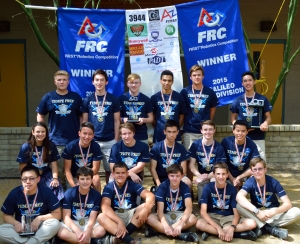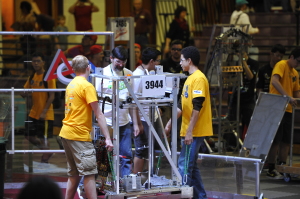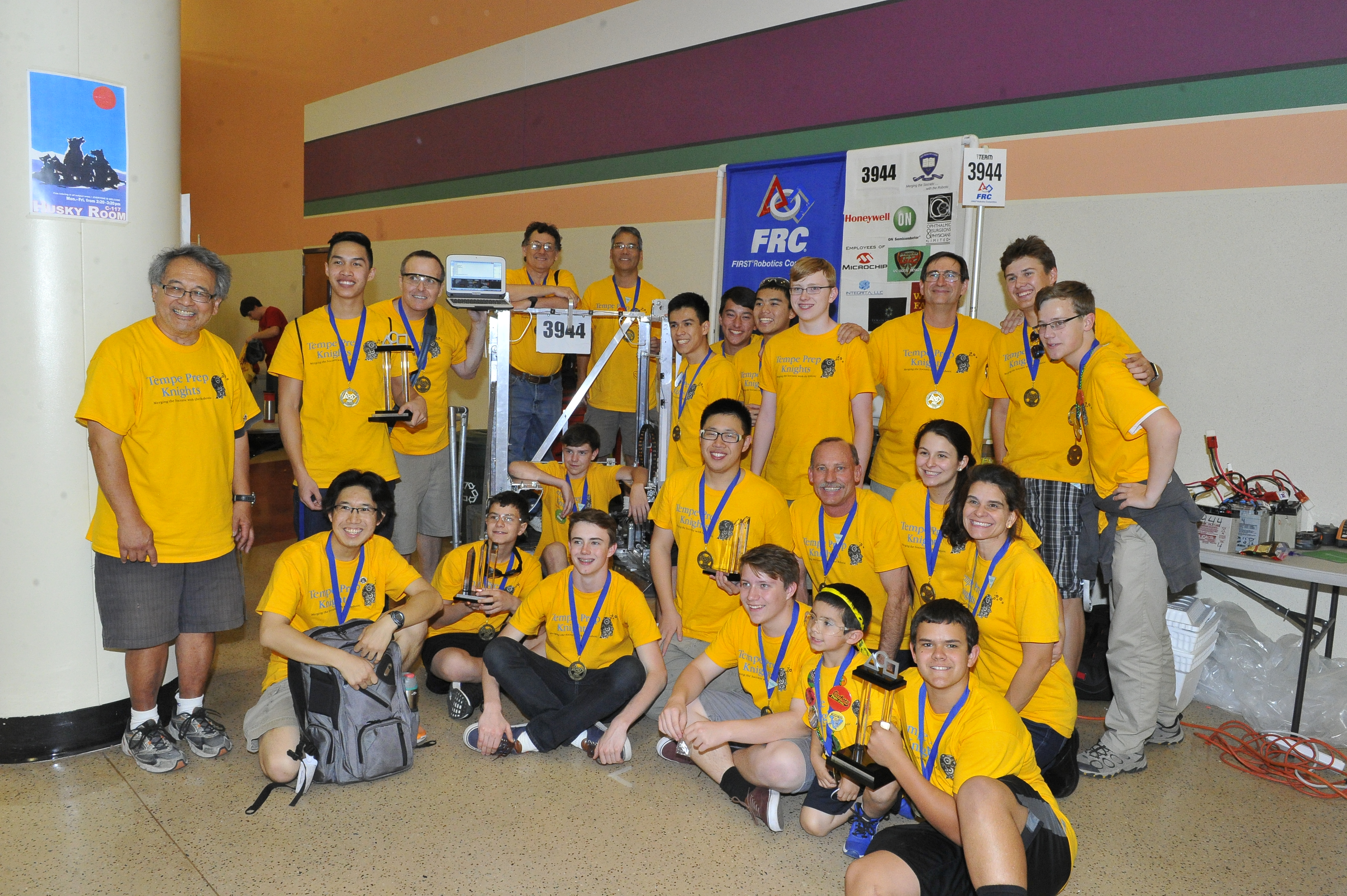By Sammy Nagy
Wednesday, April 22, after weeks of packing away parts and testing new contraptions, Tempe Prep’s robotics team, No. 3944, boarded early flights destined for St. Louis, Missouri, home of the annual FIRST Robotics World Championship. Attempting to arrive in St. Louis by the early afternoon, most of the team woke up at 4 a.m. in order to catch a 6 a.m. flight, while several other team members, such as myself, attempted to take later flights.
After braving the air in what was described by many as a monotonous and sleepless flight, the majority of the team landed at around half past two. With no time for breaks, these members rushed to drop off their personal items at the hotel and raced to set up the team’s pit area, the central location for the robot outside of the competition field. Why the rush? In order to encourage teams to arrive early, the leading figures of the FIRST Championship dedicated the day to practice, meaning that we could use the day not only to test the abilities of our own robot after its transportation, but also to start scouting out the other teams, observing what they could or could not do based upon their unique constructions.
 However, more surprises laid in store for the team, as they quickly discovered the immense size of the competition. Packed into the St. Louis convention center and football stadium were over 600 other teams, some of which had upwards of 50 members and mentors. “It was competitive and crazy,” says Jacob Steineke, “and scouting was tedious, but it paid off in the end.”
However, more surprises laid in store for the team, as they quickly discovered the immense size of the competition. Packed into the St. Louis convention center and football stadium were over 600 other teams, some of which had upwards of 50 members and mentors. “It was competitive and crazy,” says Jacob Steineke, “and scouting was tedious, but it paid off in the end.”
The day wrapped up at 8 o’clock, with the team returning exhausted yet excited. It was also around this time that I arrived, ready to begin work the next day. Thursday the 23rd brought with it the official start of the competition, along with another early wake-up at 5 in the morning. However, most everyone was quickly shaken from their slumber at the mere thought of the events that lay in store for them, for that day was the first dedicated to qualification rounds, where we would attempt to achieve the highest possible scoring average across ten separate matches.
The day started off strongly, with the team scoring an incredible 170 plus points in its first round. However, after only one low scoring round, we slumped from seventh place to 69th out of 72 teams. To counter this setback required the incredible commitment and endurance of everyone involved, from those members of the scouting team that stayed immobile, observantly watching the matches for six hours on end, to those working furiously in the pit.
“We had everything under control, but it was tiresome, and we ended up working around the clock, on and off the competition field” says Olek Piechaczek, the human interactive player for the team in charge of the human loading station. Together, these actions ensured a steady comeback, resulting in our team finishing the day around 30th place.
Returning to the hotel, everyone was finally able to relax and unwind. “In our room, we watched Modern Family,” says Olek, “and had fun throwing around Frisbees.”
 The next and final day of qualification matches was quite similar to the first: an early wake-up, followed by eight straight hours of qualification matches. Throughout the day, we continued to increase our qualification average score, reaching our peak at 21st place. However, in a twist of misfortune, our final round shot us down to 35th place, dashing our high hopes of being selected in the following day’s elimination rounds. With only eight teams picking two partners and a backup, usually only the top 24 teams get a chance to compete.
The next and final day of qualification matches was quite similar to the first: an early wake-up, followed by eight straight hours of qualification matches. Throughout the day, we continued to increase our qualification average score, reaching our peak at 21st place. However, in a twist of misfortune, our final round shot us down to 35th place, dashing our high hopes of being selected in the following day’s elimination rounds. With only eight teams picking two partners and a backup, usually only the top 24 teams get a chance to compete.
Returning to the hotel, the team still had hope, as our robot had the distinct advantage of consistently high stacks of totes throughout each performance. At last, after what had seemed like an eternity, the final day of the competition arrived. Marching into the stands together, the team awaited the judgment of the top eight seeded teams. One by one, they carefully selected alliance partners, knowing full well which teams best complemented them. Left un-selected as a direct partner, and with only two slots left for what seemed at the time to be menial backup positions, we were chosen by the second seeded alliance, and were caught in a position we truly had not anticipated.
Indeed, while we had planned to either be selected as a competing member in an alliance or to be rejected entirely, we had not anticipated waiting around as a backup, providing support only if one of the other robots had a malfunction. With a general air of disappointment, the team gathered together, anticipating a long and monotonous wait on the sidelines. Suddenly, as if by a stroke of good fortune, one of the teams on the alliance decided it wanted to spend time installing a new and experimental component, allowing us to take their position.
Quickly we rushed back into the stands and our robot blazed through the elimination rounds, from the quarterfinals, to the semifinals, and even to the final round. At last, our tenacity had paid off, for after two close rounds we and our alliance partners finally took first place, guaranteeing our spot in the championship’s final rounds.
Here we were, having achieved what we would have previously thought un-achievable, participating in front of a crowd of over 40,000 attendees and knowing that there were only 24 other teams left in the competition.
Unfortunately, the quarterfinal rounds were unforgiving. With just two rounds to achieve the highest possible average score, a single, faulty round took us from the first seed to the fifth, eliminating us from the competition. However, once our immediate feelings passed, we could only sit back and recall with pride our incredible accomplishments. Out of 2,500 plus international competing teams, we had been one of 600 plus to make it to the world championship, and of those 600 plus, we had come in 15th place.
As Victor Dinh summarized, “It was really fun, everyone was kind and encouraging, and the competition itself was fantastic.”
